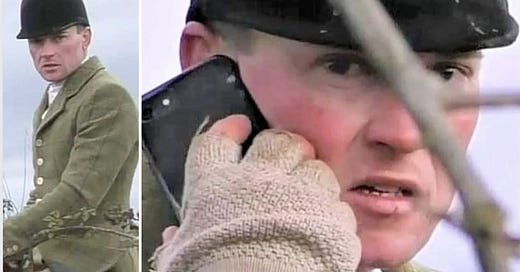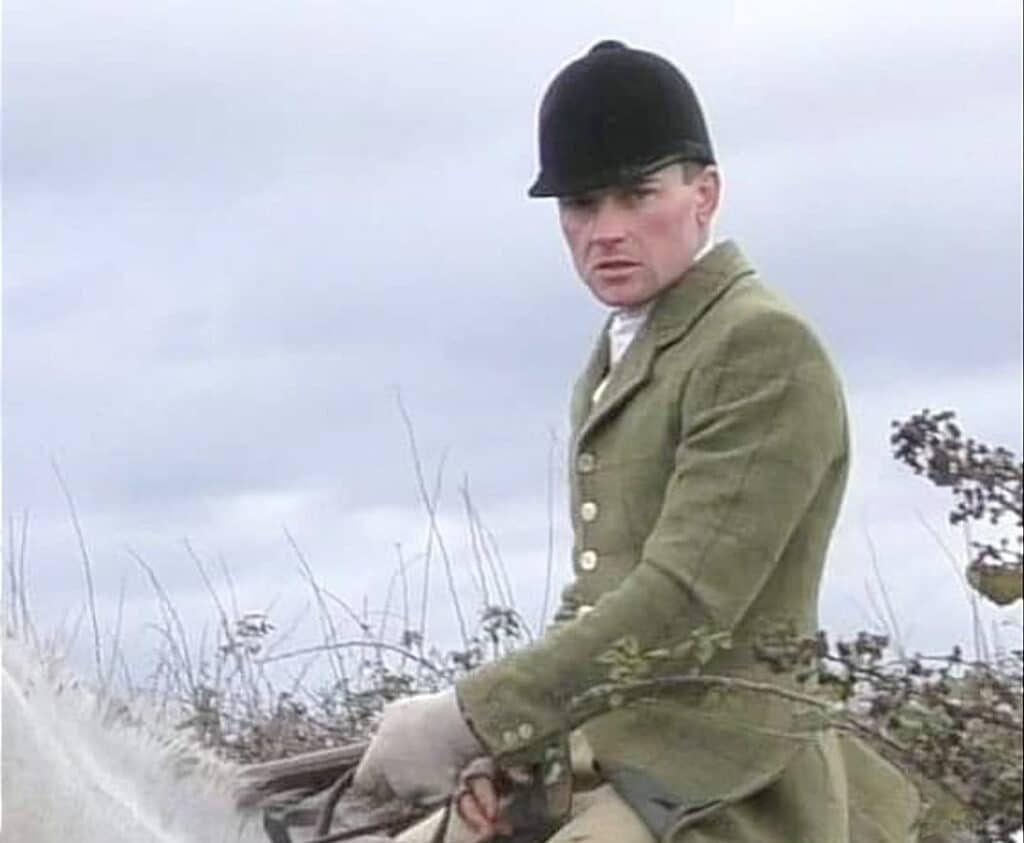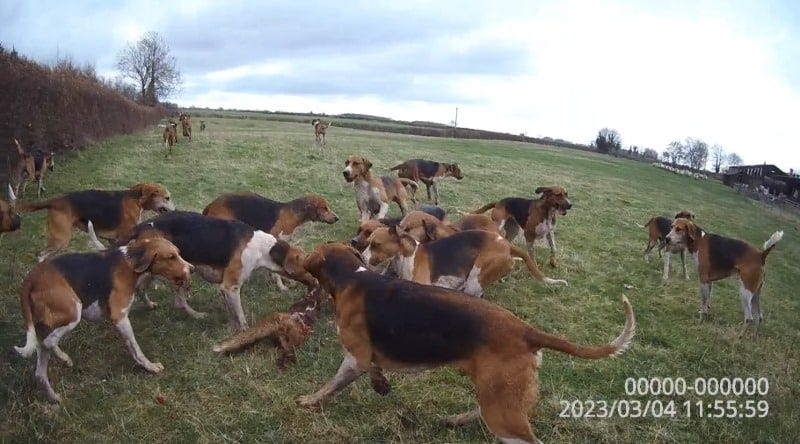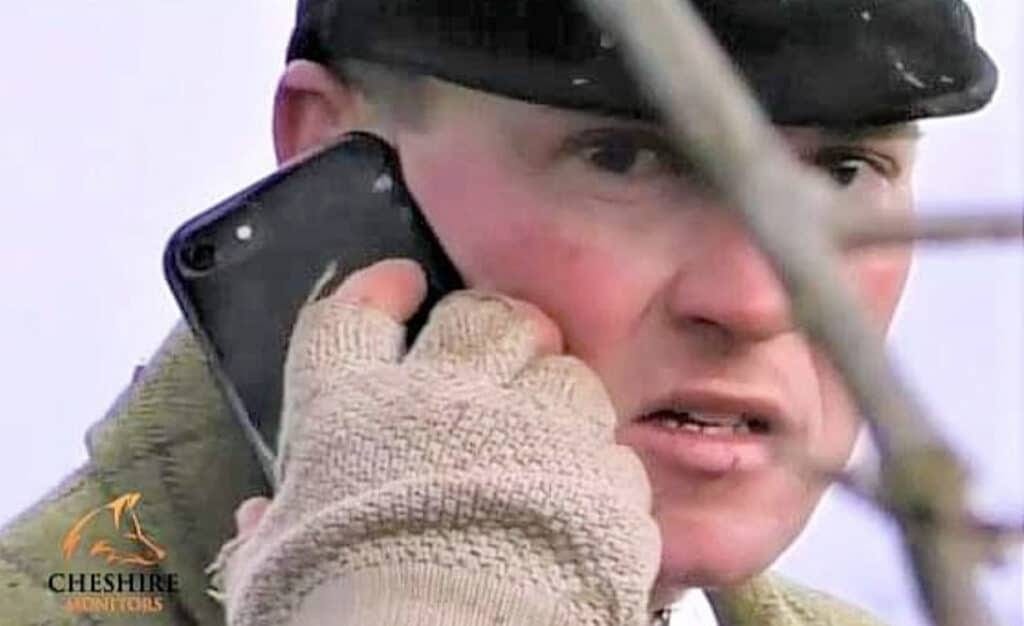What did it take to convict huntsman Chris Woodward?
A look at the evidence gathered by Cheshire Borderland Monitors
Last month Protect the Wild reported that the Wynnstay Hunt's serial criminal former-huntsman Chris Woodward had been convicted of hunting a wild animal with dogs in Lower Wych, Wrexham, on 14 January 2023.
Evidence for the conviction had come from Cheshire Borderland Monitors volunteers who had filmed Woodward galloping down a road after his hounds and subsequently hunting across a field. The evidence the monitors collected persuaded the Crown Prosecution Service (CPS) to pursue the case in court.
Last week the Monitors posted an account on Facebook of Woodward's court appearance and briefly explained how the video they'd taken (which they published in full) had been used to convict him.
Many people leave comments on Protect the Wild asking why it is so hard to convict someone for hunting under the Hunting Act 2004, and we thought that a brief look at this case might go some way to providing an answer.
(We've covered the Hunting Act and so-called 'trail laying' (where a scent trail is allegedly laid in advance of a hunt) in detail in other posts and pages (see for example, our Protectors of the Wild page on the Hunting Act 2004) so will focus on two other elements here instead that are crucial for a successful case: identification and intent).
Why is it so hard to prove illegal hunting?
If you go out dressed as a fox hunter, with a bunch of other fox hunters, and you take with you a pack of hunting hounds trained to hunt foxes, the obvious conclusion (to quote the 'If it looks like a duck, walks like a duck and quacks like a duck...it's a duck' idiom) is that you are indeed fox hunting. The law though, to quote legal text, demands evidence "as a means of ascertaining the truth of any alleged matter of fact under investigation before it". No one would seriously argue that the law could be applied differently to different people (even fox hunters), but as Cheshire Borderland Monitors explained in their post the evidence bar needed for a successful prosecution is set very high indeed.
Typically to pass that bar, evidence (preferably presented in high-definition video) needs to include:
The fox running.
The hounds in pursuit.
The huntsman in view of the fox and encouraging the hounds to chase it using horn or voice calls.
All three elements need to be clearly established to even begin to convince a court that illegal hunting was taking place. It's not too difficult to obtain video of a running fox or of running hounds, and most observers will recognise the sound of chasing dogs in full cry - but of course animals can't be charged with illegal hunting (in the jargon, 'non-human animals lack moral agency and so cannot be held culpable for an act'). The case is always all about the role of the huntsman.
Which is where defence lawyers routinely depend on the two other elements we mentioned earlier: identification and intent.
Chris Woodward. Serial criminal and former Wynnstay Hunt huntsman, Image Cheshire Borderland Monitors
Identification and intent
We're not lawyers here at Protect the Wild, but we are deeply interested in natural justice. We're pretty sure that any of us faced with the possibility of a conviction in court would insist that the evidence used against us is as conclusive as possible. There are far too many cases of mistaken identity (deliberate or otherwise), and - if we had broken the law - we'd hope the court would have unequivocal evidence to prove it was us who'd 'done it', and would take into account whether we meant to commit a crime (had intent) or were perhaps in the wrong place at the wrong time or that events had spiralled out of our control before the crime was committed.
However, there are far too many examples of the police or the Crown Prosecution Service not taking a case to court even when - at least from the outside - the evidence seems indisputable. Why is that? Because of the fog of uncertainty that the 'lawful activity' of hunting has successfully wrapped itself in...
In every criminal case the prosecution must prove the identity of the 'person who perpetrated or participated in the commission of an offence'. Defendants in hunting cases will often claim that the evidence being presented doesn't specifically identify them as the individual who was allegedly hunting illegally - it's usually obvious that they were present at a hunt meet (monitors and sabs deliberately film as many of the senior hunters present as possible) but while they may have been there, they'll say, they weren't hunting. They were bystanders when a kill took place, or were charging down the road simply in an effort to bring the hounds under control before a crime was committed.
Defence lawyers might also suggest that even if an individual is identified. the hunting was a 'temporary lapse': in other words, they will claim that the defendant was hunting legally all day (using the so-called ‘trail hunting’ exemption) but for a moment they had a 'temporary lapse' when they saw the hounds chasing a fox and did not do as much as they could to stop them.
To observers on the ground on the day these 'excuses' are clearly lies, but proving that with evidence is extremely difficult.
Most importantly perhaps, in 1969 the House of Lords ruled that intent is important in criminal acts in establishing guilt in all ordinary cases.
Intent - 'the decision to bring about a prohibited consequence' - is critical therefore, and has been leapt on by hunts (and their defence attorneys) because successful Hunting Act prosecutions must prove that hunts (again, no matter what is obvious from the outside) meant or intended to kill a wild animal. To convict someone (and this is a layperson's interpretation and over-simplified) it must be proven that when planning an action the defendant was aware of the many 'probable and possible consequences'. Again, that's extremely difficult to prove and a major deterrent for taking cases to court.
Holderness Hunt hounds kill a fox. Image Hull Wildlife Protectors
As an example, it's well worth reading the account we posted of the Holderness Hunt killing a fox in front of Hull Wildlife Monitors, where monitors filmed a fox being killed by the Hunt's hounds but Humberside Police wouldn't pursue charges against the individuals involved due to 'evidential difficulties to prove beyond reasonable doubt that the hunting of the wild mammal was intentional'.
So why was this particular case successful?
As we stated at the top of this post, Woodward is a serial criminal. He pleaded guilty to causing intentional harassment, alarm or distress by riding his horse at a Cheshire Borderlands Monitor volunteer during a meet in January 2023 and was convicted in August 2023 of interfering with a badger sett (hunts will illegally block the entrances to badger setts to stop foxes escaping to safety underground).
Woodward has form, in other words. As the Sentencing Academy states,
"Where offenders have previously been convicted of one or more criminal offences, the court must take this previous offending into account as an aggravating factor when sentencing in respect of a new offence, providing that it considers that it is 'reasonable' to do so."
So we have a convicted criminal engaged in alleged hunting. In this case the evidence is also very good. If you watch the video there is no doubt that the hounds are chasing a fox - they are all funneled down the same stretch of narrow road for one thing. They are quickly followed by Woodward (who was clearly recorded and identified at the meet) and other members of the Wynnstay Hunt. A monitor can clearly be heard on the video shouting to Woodward that the hounds were 'on' the fox and should be called off in line with the Hunting Act.
The evidence seemed to undermine any possible defence Woodward's lawyer might put forward. In fact, Cheshire Borderland Monitors report in their account of the case that the defence lawyer "seemed resigned to the fact that Woodward was a serial offender and was struggling to defend him".
More importantly, the monitors state that the CPS prosecution lawyer, Suzanne Cartwright, 'pinned' Woodward down and refused to believe what - based on the evidence presented - were clearly lies being put forward as defence. Ms Cartwright clearly believed the evidence was credible, showed illegal hunting, plainly identified Woodward, and proved intent.
The monitors say in their post that:
"When Woodward told the court that he hadn't seen or heard our monitor warn him she had seen the fox Suzanne Cartwright told him "Mr Woodward, you and your little community have an attitude, don't you?", "you have contempt for the monitor and others like her don't you?", "that's why you ignored her when she told you about the fox, wasn't it Mr Woodward?", "you were doing this for pleasure and telling us it was an accident, weren't you Mr Woodward?" and "it was an opportunity and you allowed the hounds to pursue the fox!"
Chris Woodward. Serial criminal and former Wynnstay Hunt huntsman, Image Cheshire Borderland Monitors
Shamed, fined and thinking of leaving hunting
The magistrate agreed with the highly laudable Ms Cartwright, telling Woodward "you are an experienced huntsman who knows your pack and deliberately allowed them to pursue the fox". Woodward was shamed, fined and, we are told, is now seriously considering leaving the hunt service altogether (and why any hunt trying to convince an increasingly sceptical and angry public that they are hunting within the law would want to employ him is a question only they can answer).
In this case, then, all the elements came together to secure a conviction: video obtained by the excellent Cheshire Borderland Monitors passed the evidence bar, the hunter in the dock was a serial offender who was clearly identified, and the CPS lawyer recognised 'intent' and was prepared to take the case forward.
Which all sounds quite simple, but of course it's not. The monitors might not have got such convincing footage (which is testament to their experience and skill), Woodward may have hung back long enough that day to have sowed doubt that he was hunting, the police may have decided not to send the case file to the CPS, the defence lawyer could have put forward a more robust defence, and the CPS may have decided that there wasn't 'enough evidence against the suspect to provide a realistic prospect of conviction' or was not convinced that a court would be 'more likely than not to find the defendant guilty when it's heard all the evidence'.
It is very difficult to get a conviction. Huge congratulations to Cheshire Borderland Monitors for resolutely pushing for Woodward to face court, and thank you to everyone involved in successfully convicting (again) one of hunting's nastiest repeat offenders.
We'd like to leave the final word to Cheshire Borderland Monitors who told Protect the Wild:
"After monitoring the Wynnstay since the ban, witnessing them chasing and killing foxes for so long and having two previous cases of illegal hunting unsuccessful we are very pleased that this one was successful.
Despite the evidence here being strong there was a strong chance that, like in the past, it wouldn't make it but hopefully this guilty verdict may set a precedent for other cases across the country."
Header image of Chris Woodward by Cheshire Borderland Monitors
Protect the Wild is grateful to Cheshire Borderland Monitors for their help with writing this post.
Protect the Wild is proud to have provided equipment to Cheshire Borderland Monitors through our Equipment Fund - please read 'Radios to monitor the Wynnstay Hunt'
You can support Cheshire Borderland Monitors by donating to the group here, or you can volunteer with them on the ground. Find out more about volunteering with them here.









Congratulations and THANK YOU to CBM and all involved! We need a few more determined lawyers like that! Praise due to her and the Magistrate concerned!
miscreants, all of them. What kind of vile excuse for a human can derive pleasure from participating in this barbarism ?